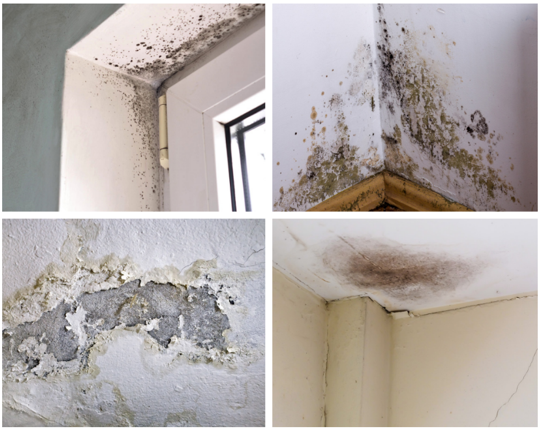Damp and mould - Private Renters in Camden
Damp and mould
We want to make sure everyone in Camden is living in homes that are free from damp and mould. On this page you’ll find information about the causes of damp and mould and what it looks like, what you can do to prevent it, and when your landlord should take action.
What causes damp and mould?
Damp is the most common cause of mould indoors. It can grow in wet or moist areas caused by leaks or when a home does not get enough ventilation. Moist areas can include:
- walls or wallpaper
- ceilings
- bathroom tiles
- carpets
- wood
How does mould affect health?
Breathing in or touching mould can cause allergic reactions in some people such as:
- sneezing
- runny noses
- red eyes and skin rashes
- breathing problems like asthma and chest infections and can make existing breathing problems worse.
- persistent exposure to airborne mould can also cause sensitisation in non sensitive persons.
Who is most affected?
Exposure to damp and mould can cause health problems in some people. This can include:
- babies and children
- those with skin problems those with skin problems like rashes or eczema
- those with breathing problems like asthma or allergies
- those with weakened immune systems that might be having chemotherapy
What does damp and mould look like?

Types of damp – condensation, rising and penetrating
Condensation
Condensation is the most common type of damp in rented properties. It appears when there is an imbalance between heating, insulation, ventilation and humidity.
When moisture in the air makes contact with cold surfaces such as windows or cold walls, the water condenses onto the cold surface and black mould can grow around windows, behind furniture and in corners of rooms.
If the mould is not wiped regularly, mould will start to grow in small spots and could spread.
Your landlord has a responsibility to take action in relation to damp and mould growth in some circumstances. For example if your heating is not working it is your landlords responsibility to fix it.
Your responsibility as a tenant
You have a responsibility to manage moisture to reduce condensation by ventilating and heating your home. Everyday activities such as showering, cooking and drying clothes can cause condensation.
How to reduce condensation:
- Cover pans when cooking
- Use extractor fans in kitchens and bathrooms
- Close doors when you are cooking or showering
- Leave a gap between furniture and walls
- Dry clothes in well ventilated area
- Open windows at least once a day for short periods at a time to let warm moisture out, but do not leave them open all day as this can make your home colder which could make condensation worse
- Try to heat your home
Penetrating damp
Penetrating damp is caused by moisture entering into external walls for example through a crack, burst pipe or rain water. Penetrating damp can also get into homes from plumbing problems in the building.
Your landlord is usually responsible for carrying out works to fix penetrating damp.
Rising damp
Rising damp is when moisture rises up through a wall or floor. Usually because of a defect of the structure. Rising damp will require further investigation by specialist contractors.
Your landlord is responsible for carrying out works to fix rising damp.
When should my landlord take action?
Your landlord should fix the damp and mould problem if it is:
- caused by a repair that’s needed
- affecting your health
Report the damp and mould problem to your landlord. Your landlord is usually required to investigate and carry out necessary works to fix the damp and mould within a reasonable timeframe.
Who do I contact if my landlord does not take action?
If your landlord does not take action after you have reported the damp and mould, contact the Private Sector Housing Service on 020 7974 5969 or complete our Get Help form.
A Camden Council environmental health officer will visit your home to carry out an assessment.
If you would like further information on how Camden Council responds to damp and mould complaints, please see our damp and mould framework.
Can I take action against my landlord?
You can take civil action against your landlord if you believe your home is not fit for human habitation through Homes (Fitness for Human Habitation) Act 2018. Find out more in the Government’s guide here.
